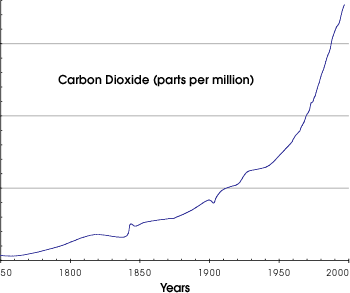

Earth is a Dynamic Planet | |||
Change is perhaps the only constant in our planet's history. Since the Earth's beginning about 4.5 billion years ago, natural climate and environmental conditions on our planet have been in constant flux. Solar variability, volcanic eruptions, meteor impacts, the emergence of life, the formation of an atmosphere rich in oxygen and greenhouse gases, changing ocean circulation patterns, wildfires—over the millennia these and other geological forces shaped an intricately intertwined global climate system that we are only just beginning to understand.
Fast
forward to the late 1800s and witness the arrival of a new and
profound force for change—humankind's Industrial Revolution. The
Industrial Revolution not only ushered in a new era of prosperity for
many, it also gave us the tools to dramatically reshape our environment.
But the impact we are having on our environment appears to have set the
wheels of climate change in motion at a rate not seen on Earth for
millions of years. Over the last 100 years, the human population has
tripled. In that time, we consumed fossil fuels in increasing amounts
to feed our rapidly industrializing economies, raising atmospheric
carbon dioxide levels by 25 percent. We burned away forests to make
room for our cities and roads, releasing carbon dioxide as well as
eliminating trees that would otherwise be absorbing some of the gas back
out of the air during photosynthesis. Over the last three decades,
humans burned an average of 75 million acres of forestland every year.
We introduced chlorofluorocarbons into the air that destroy ozone in the
stratosphere. Without its stratospheric ozone shield, the surface of
our world would be exposed to the sun's harmful ultraviolet rays, and
life as we know it couldn't exist. Due, at least in part, to the rising
levels of carbon dioxide, the average global temperature has risen 0.5°C
over the last century, and some computer models predict it could rise
another 1°C over the next century. Already we see the polar ice caps
melting at an alarming rate, while an average of two to three glaciers
disappear worldwide every week. Geologists speculate that the U.S.
Glacier National Park will contain no glaciers by the year 2050. |
 Space-based Observations of the Earth Introduction
| ||
 |
 This graph shows changes in the concentration of carbon dioxide in the atmosphere over time. Carbon dioxide has built up rapidly in the atmosphere since the beginning of the Industrial Revolution. Levels are now more than 40 percent higher than they were in 1750. (Graph by Robert Simmon, based on data from NOAA) What precisely are the causes of these changes? Which changes can be attributed to natural variability, and which are human-induced? How will these changes affect weather and climate patterns in the 21st century? How will climate and environmental change impact the quality of life for our grandchildren, and theirs? To help answer these questions and more, NASA developed a new series of satellite remote sensors, beginning with the Earth Resources Technology Satellite (ERTS) launched in 1972 (and later renamed Landsat 1). next: From Observing to Measuring Changes on
Earth
| ||